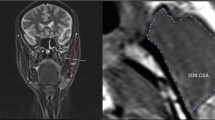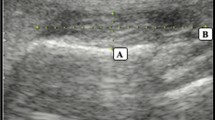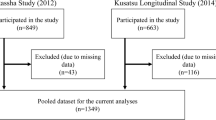Abstract
Objectives
This study aimed to investigate the relationship between aging and tooth loss on masseter muscle quantity and quality.
Materials and methods
This cross-sectional study was conducted among 112 participants (in their 20s to 90s) who were independent in activities of daily living and were able to follow verbal commands. Exclusion criteria comprised participants with a lack of molar occlusal support, diseases that could affect muscle function, or temporomandibular disorder. Age, tooth loss, and weight were documented, and masseter muscle thickness (MMT) and masseter muscle echo intensity (MMEI) were measured using an ultrasonic diagnostic apparatus. A multiple regression analysis was used to determine the relationship between MMT, MMEI, aging, and tooth loss, among each sex. The significance level in the statistical analysis was p < 0.05.
Results
In males, aging was a significant explanatory variable for MMT (adjusted R2 = 0.27), while both aging and weight were significantly associated with MMEI (adjusted R2 = 0.54). In females, tooth loss and aging were significant explanatory variables for MMT (adjusted R2 = 0.36) and MMEI (adjusted R2 = 0.5), respectively. In both men and women, MMT and MMEI were highly correlated.
Conclusions
Masseter muscles in males were more likely to be attenuated by aging than in females. The main attenuation factors were observed to differ between MMT and MMEI in women.
Clinical relevance
In females, preservation of the natural dentition or prosthetic treatment may be effective for maintaining masseter muscle characteristics. In males, additional approaches, such as resistance exercise training, may be necessary.


Similar content being viewed by others
References
Ikebe K, Matsuda K, Kagawa R, Enoki K, Okada T, Yoshida M, Maeda Y (2012) Masticatory performance in older subjects with varying degrees of tooth loss. J Dent 40:71–76. https://doi.org/10.1016/j.jdent.2011.10.007
Utanohara Y, Hayashi R, Yoshikawa M, Yoshida M, Tsuga K, Akagawa Y (2008) Standard values of maximum tongue pressure taken using newly developed disposable tongue pressure measurement device. Dysphagia 23:286–290. https://doi.org/10.1007/s00455-007-9142-z
Castrejón-Pérez RC, Jiménez-Corona A, Bernabé E, Villa-Romero AR, Arrivé E, Dartigues JF, Gutiérrez-Robledo LM, Borges-Yáñez SA (2017) Oral disease and 3-year incidence of frailty in Mexican older adults. J Gerontol A Biol Sci Med Sci 72:951–957. https://doi.org/10.1093/gerona/glw201
Sheiham A, Steele JG, Marcenes W, Lowe C, Finch S, Bates CJ, Prentice A, Walls AW (2001) The relationship among dental status, nutrient intake, and nutritional status in older people. J Dent Res 80:408–413. https://doi.org/10.1177/00220345010800020201
Tanaka T, Takahashi K, Hirano H, Kikutani T, Watanabe Y, Ohara Y, Furuya H, Tetsuo T, Akishita M, Iijima K (2018) Oral frailty as a risk factor for physical frailty and mortality in community-dwelling elderly. J Gerontol A Biol Sci Med Sci 73:1661–1667. https://doi.org/10.1093/gerona/glx225
Yamaguchi K, Tohara H, Hara K, Chantaramanee A, Nakagawa K, Yoshimi K, Nakane A, Minakuchi S (2019) Tongue thickness is associated with masticatory performance of perioral muscles: ultrasonographic study of perioral muscle characteristics in healthy young subjects. J Oral Rehabil. https://doi.org/10.1111/joor.12909
Yoshimi K, Hara K, Tohara H, Nakane A, Nakagawa K, Yamaguchi K, Kurosawa Y, Yoshida S, Ariya C, Minakuchi S (2018) Relationship between swallowing muscles and trunk muscle mass in healthy elderly individuals: a cross-sectional study. Arch Gerontol Geriatr 79:21–26. https://doi.org/10.1016/j.archger.2018.07.018
Umemoto G, Furuya H, Arahata H, Sugahara M, Sakai M, Tsuboi Y (2016) Relationship between tongue thickness and tongue pressure in neuromuscular disorders. Neurol Clin Neurosci 4:142–145. https://doi.org/10.1111/ncn3.12058
Baba T, Goto T, Fujimoto K, Suito H, Yagi K, Nagao K, Ichikawa T (2018) The geniohyoid muscle directly affects masticatory function: evaluation with decision-tree analysis. Int J Prosthodont 31:569–572. https://doi.org/10.11607/ijp.5862
Kajisa E, Tohara H, Nakane A, Wakasugi Y, Hara K, Yamaguchi K, Yoshimi K, Minakuchi S (2018) The relationship between jaw-opening force and the cross-sectional area of the suprahyoid muscles in healthy elderly. J Oral Rehabil 45:222–227. https://doi.org/10.1111/joor.12596
Young HJ, Jenkins NT, Zhao Q, Mccully KK (2015) Measurement of intramuscular fat by muscle echo intensity. Muscle Nerve 52:963–971. https://doi.org/10.1002/mus.24656
Pillen S, Tak RO, Zwarts MJ, Lammens MM, Verrijp KN, Arts IM, van der Laak JA, Hoogerbrugge PM, van Engelen BG, Verrips A (2009) Skeletal muscle ultrasound: correlation between fibrous tissue and echo intensity. Ultrasound Med Biol 35:443–446. https://doi.org/10.1016/j.ultrasmedbio.2008.09.016
Rech A, Radaelli R, Goltz FR, da Rosa LH, Schneider CD, Pinto RS (2014) Echo intensity is negatively associated with functional capacity in older women. Age (Dordr) 36:9708. https://doi.org/10.1007/s11357-014-9708-2
Yamada M, Kimura Y, Ishiyama D, Nishio N, Abe Y, Kakehi T, Fujimoto J, Tanaka T, Ohji S, Otobe Y, Koyama S, Okajima Y, Arai H (2017) Differential characteristics of skeletal muscle in community-dwelling older adults. J Am Med Dir Assoc 18:807.e9. https://doi.org/10.1016/j.jamda.2017.05.011
Feng X, Todd T, Lintzenich CR, Ding J, Carr JJ, Ge Y, Browne JD, Kritchevsky SB, Butler SG (2013) Aging-related geniohyoid muscle atrophy is related to aspiration status in healthy older adults. J Gerontol A Biol Sci Med Sci 68:853–860. https://doi.org/10.1093/gerona/gls225
Bhoyar PS, Godbole SR, Thombare RU, Pakhan AJ (2012) Effect of complete edentulism on masseter muscle thickness and changes after complete denture rehabilitation: an ultrasonographic study. J Investig Clin Dent 3:45–50. https://doi.org/10.1111/j.2041-1626.2011.0088.x
Eichner K (1955) Über eine Gruppeneintelung des lückengebisses für die prothetik. Dtsch Zahnarztl Z 10:1831–1834
Serra MD, Duarte Gavião MB, dos Santos Uchôa MN (2008) The use of ultrasound in the investigation of the muscles of mastication. Ultrasound Med Biol 34:1875–1884. https://doi.org/10.1016/j.ultrasmedbio.2008.05.009
Yamaguchi K, Tohara H, Hara K, Nakane A, Yoshimi K, Nakagawa K, Minakuchi S (2019) Factors associated with masseter muscle quality assessed from ultrasonography in community dwelling elderly individuals:a cross-sectional study. Arch Gerontol Geriatr 82:128–132. https://doi.org/10.1016/j.archger.2019.02.003
Palinkas M, Nassar MS, Cecílio FA, Siéssere S, Semprini M, Machado-de-Sousa JP, Hallak JE, Regalo SC (2010) Age and gender influence on maximal bite force and masticatory muscles thickness. Arch Oral Biol 55:797–802. https://doi.org/10.1016/j.archoralbio.2010.06.016
Albani D, Batelli S, Polito L, Vittori A, Pesaresi M, Gajo GB, De Angeli S, Zanardo A, Gallucci M, Forloni G (2009) A polymorphic variant of the insulin-like growth factor 1 (IGF-1) receptor correlates with male longevity in the Italian population: a genetic study and evaluation of circulating IGF-1 from the "Treviso Longeva (TRELONG)" study. BMC Geriatr 9:19. https://doi.org/10.1186/1471-2318-9-19
Widmer CG, Morris-Wiman J (2010) Limb, respiratory, and masticatory muscle compartmentalization: developmental and hormonal considerations. Prog Brain Res 187:63–80. https://doi.org/10.1016/B978-0-444-53613-6.00005-8
Sato Y, Tanda H, Kato S, Onishi S, Nakajima H, Nanbu A, Nitta T, Koroku M, Akagashi K, Hanzawa T, Shinozaki T, Terao N, Fujisaki N, Kuwabara M, Niimura K (2006) Serum testosterone levels using the radioimmunoassay method in healthy Japanese male volunteers. Reprod Med Biol 5:37–41. https://doi.org/10.1111/j.1447-0578.2006.00121.x
Haring R, Hannemann A, John U, Radke D, Nauck M, Wallaschofski H, Owen L, Adaway J, Keevil BG, Brabant G (2012) Age-specific reference ranges for serum testosterone and androstenedione concentrations in women measured by liquid chromatography-tandem mass spectrometry. J Clin Endocrinol Metab 97:408–415. https://doi.org/10.1210/jc.2011-2134
Hawke TJ, Garry DJ (2001) Myogenic satellite cells: physiology to molecular biology. J Appl Physiol 91:534–551. https://doi.org/10.1152/jappl.2001.91.2.534
Uezumi A, Fukada S, Yamamoto N, Takeda S, Tsuchida K (2010) Mesenchymal progenitors distinct from satellite cells contribute to ectopic fat cell formation in skeletal muscle. Nat Cell Biol 12:143–152. https://doi.org/10.1038/ncb2014
Joe AW, Yi L, Natarajan A, Le Grand F, So L, Wang J, Rudnicki MA, Rossi FM (2010) Muscle injury activates resident fibro/adipogenic progenitors that facilitate myogenesis. Nat Cell Biol 12:153–163. https://doi.org/10.1038/ncb2015
Verdijk LB, Koopman R, Schaart G, Meijer K, Savelberg HH, van Loon LJ (2007) Satellite cell content is specifically reduced in type II skeletal muscle fibers in the elderly. Am J Physiol Endocrinol Metab 292:E151–E157. https://doi.org/10.1152/ajpendo.00278.2006
Osterlund C, Thornell LE, Eriksson PO (2011) Differences in fibre type composition between human masseter and biceps muscles in young and adults reveal unique masseter fibre type growth pattern. Anat Rec (Hoboken) 294:1158–1169. https://doi.org/10.1002/ar.21272
Raadsheer MC, van Eijden TM, van Ginkel FC, Prahl-Andersen B (1999) Contribution of jaw muscle size and craniofacial morphology to human bite force magnitude. J Dent Res 78:31–42
Umeki K, Watanabe Y, Hirano H, Edahiro A, Ohara Y, Yoshida H, Obuchi S, Kawai H, Murakami M, Takagi D, Ihara K, Igarashi K, Ito M, Kawai Y (2018) The relationship between masseter muscle thickness and appendicular skeletal muscle mass in Japanese community-dwelling elders: a cross-sectional study. Arch Gerontol Geriatr 78:18–22. https://doi.org/10.1016/j.archger.2018.05.014
Yamaguchi K, Tohara H, Hara K, Nakane A, Kajisa E, Yoshimi K, Minakuchi S (2018) Relationship of aging, skeletal muscle mass, and tooth loss with masseter muscle thickness. BMC Geriatr 18:67. https://doi.org/10.1186/s12877-018-0753-z
Wallace JD, Calvo RY, Lewis PR, Brill JB, Shackford SR, Sise MJ, Sise CB, Bansal V (2017) Sarcopenia as a predictor of mortality in elderly blunt trauma patients: comparing the masseter to the psoas using computed tomography. J Trauma Acute Care Surg 82:65–72. https://doi.org/10.1097/TA.0000000000001297
Kraemer WJ, Ratamess NA, Nindl BC (2017) Recovery responses of testosterone, growth hormone, and IGF-1 after resistance exercise. J Appl Physiol 122:549–558. https://doi.org/10.1152/japplphysiol.00599.2016
Acknowledgments
The authors would like to thank Editage (http://www.editage.com) for editing and proofreading this manuscript for English language and all staff members and participants of the study.
Author information
Authors and Affiliations
Contributions
All authors contributed to the study conception and design. Material preparation, data collection, and analysis were performed by Kohei Yamaguchi, Chizuru Namiki, and Chantaramanee Ariya. The first draft of the manuscript was written by Kohei Yamaguchi and all authors commented on previous versions of the manuscript. All authors read and approved the final manuscript.
Corresponding author
Ethics declarations
Conflict of interest
The authors declare that they have no conflicts of interest.
Ethical approval
All procedures performed in studies involving human participants were in accordance with the ethical standards of the institutional and/or national research committee (Tokyo Medical and Dental University Ethics Committee [ref: D2014-047]) and with the 1964 Helsinki Declaration and its later amendments or comparable ethical standards.
Informed consent
Informed consent was obtained from all individual participants included in the study.
Additional information
Publisher’s note
Springer Nature remains neutral with regard to jurisdictional claims in published maps and institutional affiliations.
Rights and permissions
About this article
Cite this article
Yamaguchi, K., Hara, K., Nakagawa, K. et al. Association of aging and tooth loss with masseter muscle characteristics: an ultrasonographic study. Clin Oral Invest 24, 3881–3888 (2020). https://doi.org/10.1007/s00784-020-03255-y
Received:
Accepted:
Published:
Issue Date:
DOI: https://doi.org/10.1007/s00784-020-03255-y




